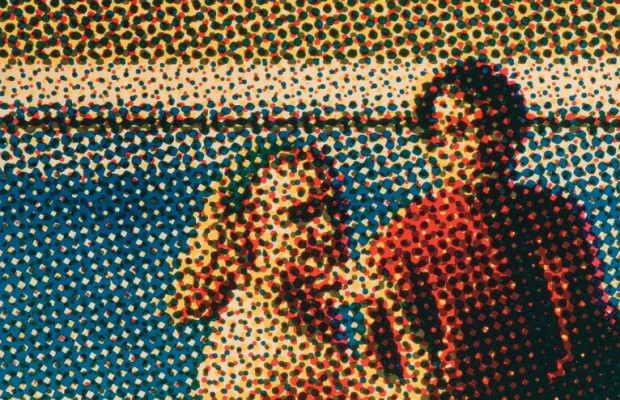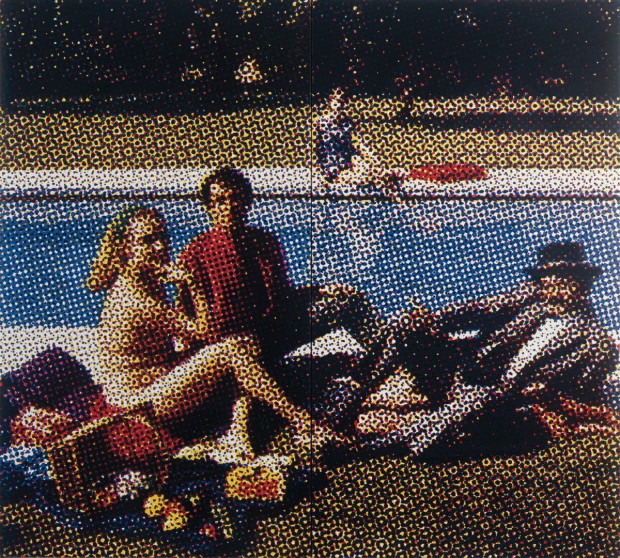An iconographic and text archive related to communication, technology and art.
☛ The Centre Pompidou: “Déjeuner sur l’herbe” (diptych) by Alain Jacquet, 1964, photo screenprint on canvas in two panels, each panel is 173.0 h x 96.5 w cm.
The large reproduction shown above is retrieved from Studio Badini Createam website: they have collected about 75 different artworks inspired by Edouard Manet “Le déjeuner sur l’herbe” (1862-63).
Alain Jacquet (1939-2008) was a French artist who worked and lived both in Paris and New York:
Mr. Jacquet, associated with Pop Art and the minimovement known as Mec Art (for mechanical art), made use of mechanical processes and advertising clichés in photoscreened works like his “Déjeuner sur l’Herbe” series. In it he posed three friends, including the French critic Pierre Restany and his wife, in modern dress and slipped in a commercially packaged loaf of bread with the label “Jacquet.” (The New York Times: “Alain Jacquet, Pop Artist Known for Playful Renditions, Is Dead at 69” by William Grimes, September 13, 2008)

Jacquet produced a whole series of variations on his interpretation of Manet’s “Déjeuner sur l’herbe”:
But by 1965 […] he had begun to create what was termed ‘MEC Art’. This involved the photo-mechanical reproduction of images by means of silkscreen printing. Like Roy Lichtenstein, who since 1961 had been mainly exploring the mechanical breakdown of images familiar from newspaper and magazine reproductions, Jacquet applied his imitation of a mass-media technique to famous work of art, as is demonstrated by this take on Manet’s Déjeuner sur l’Herbe of 1863 (Musée d’Orsay, Paris). Jacquet had friends substitute for the models used by his predecessor, thereby updating what had already constituted a complex statement about sexuality and gender. However, unlike Lichtenstein, Jacquet enlarged the constituent dots so as to make us work harder at apprehending what is visible in overall terms. He also created his imitative images in theoretically endless variations, and with intentional mis-registrations, in order to make the works look improvised. (Pop Art by Eric Shanes, Parkstone International, 2009, p. 124)
See also an short introduction to Jacquet’s art by the Musée d’Art Moderne et d’Art Contemporain of Nice (in French):
Enfin arrêtons-nous un moment devant le Déjeuner sur l’herbe qui souvent prétend à lui seul contenir tout l’œuvre de Jacquet. Ce monument de l’histoire de l’art, dérivé de Giorgione, mis en scène par Manet qui en fait magistralement le point d’entrée de la modernité est revisité par Jacquet. Il réalise un tableau vivant de la scène qu’il va photographier pour en faire la matière du fameux diptyque. Parmi les protagonistes, il choisit Pierre Restany, le mentor du Nouveau Réalisme et Jeannine Goldschmidt, la directrice de la galerie J à Paris. Si Pierre Restany accepte de poser, avec réticence car il ne semblait pas dans la confidence, c’est une manière de « parrainer » cet artiste free-lance. De cette scénographie célèbre, Jacquet fait une œuvre aux déclinaisons multiples, inscrivant les solutions diverses dans une longue perspective sérielle, en jouant sur les recadrages partiels. Le savant décalage des trames de couleur primaire, tout en masquant la signature du fabriquant du pain de mie fait définitivement recette. L’œuvre de Jacquet sera souvent identifiée à partir des registres spécifiques de ce seul tableau. C’est un peu l’arbre qui cache la forêt comme le Love de Robert Indiana qui a souvent fait écran, empêchant de voir l’ampleur de l’itinéraire de l’artiste. (read more)
- By Philippe Theophanidis
- on
- ― Published in Art, Photography, Silkscreen
- Tagged: Alain Jacquet, culture, Manet, mass media, popular culture, postmodernism, reproduction

